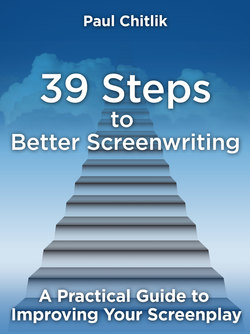Читать книгу 39 Steps to Better Screenwriting - Paul Chitlik - Страница 15
На сайте Литреса книга снята с продажи.
ОглавлениеStep 9
Dueling Protagonists, Dueling Stories
I recently gave a workshop in Australia for ScreenWest and the Australian Writers Guild. Exciting new talent there with some great stories and unusual characters. But some writers were struggling with how to tell their stories with two protagonists or, even more difficultly, with two time frames. Is this a good idea or a minefield? Sure, it can be creative, but also divisive, not allowing enough story for either.
There’s a reason that almost all movies only have one protagonist. The reader, and then the audience, needs to focus on the journey of one person. There can be others whom we follow to a lesser degree, but the movie is always centered on the one. Yes, in Thelma and Louise it was the journey of the two, but it was the arc of only one, Thelma. Louise did not change, or at least to the degree that Thelma did. Butch had longer to go than Sundance. Even Luke had more to his journey than Han Solo.
Why is this the norm? Because if you tell the story of two people, you naturally have less story for each unless they’re joined at the hip (and there has been a movie about conjoined twins, but how many movies can you make like that?). Bifurcating the storytelling means reducing by 50% the amount you can tell about each, and that’s just not satisfying to an audience. They want to follow one person on one journey. Otherwise, you’re really making two short subjects, or three or four.
Yes, there are films that do that, and do it well. Take Love, Actually, which has, I don’t know, five central figures? But that is really a series of shorts that just happen to tie together in the end. Hugh Grant is the nominal lead, but, truly, it’s the story about a group of people. While it was successful at the box office, and is a Christmas perennial, it’s the exception that proves the rule and the product of an experienced screenwriter and director, Richard Curtis. Would it be a good idea for a new writer to tackle something as structurally complex as this the first time out? No. Learn how to write a good single protagonist film first, then go after whatever you want.
One of my students’ stories took place in two different periods but with the same group of people in each. At first I thought, no, this will never work. But then the power of the relationships in the stories and the effect the first had on the second shone through, and I was convinced that it could work. However, the writer then had to re-structure both stories, strengthening the protagonist and, importantly, the person who was truly pivotal but neglected in the first telling. When I left Australia, he was well on his way to making the first story inform the second in a way that, when interwoven, would be a powerful story of people learning to let the past go and to focus on the future.
However, he had a lot of work to do. I’m confident that he’ll do it.
Of course, there are no rules in screenwriting. We’ve all learned that from films such as Another Year which grew out of improvisation and basically began without a screenplay at all. But there are guidelines and conventions. As you get started, it’s a good idea to follow those until you get control of the craft. Once you do, there is no limit to what you can do.
